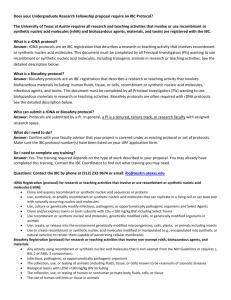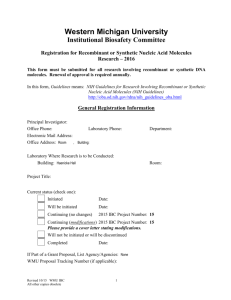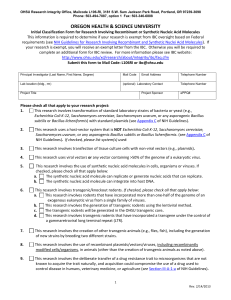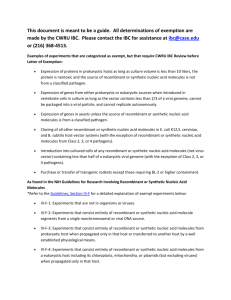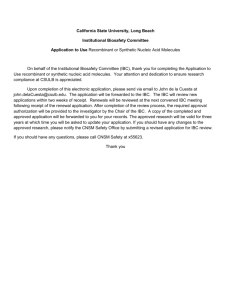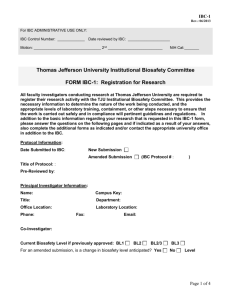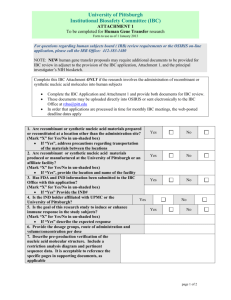Recombinant & Synthetic Nucleic Acid Molecule Research
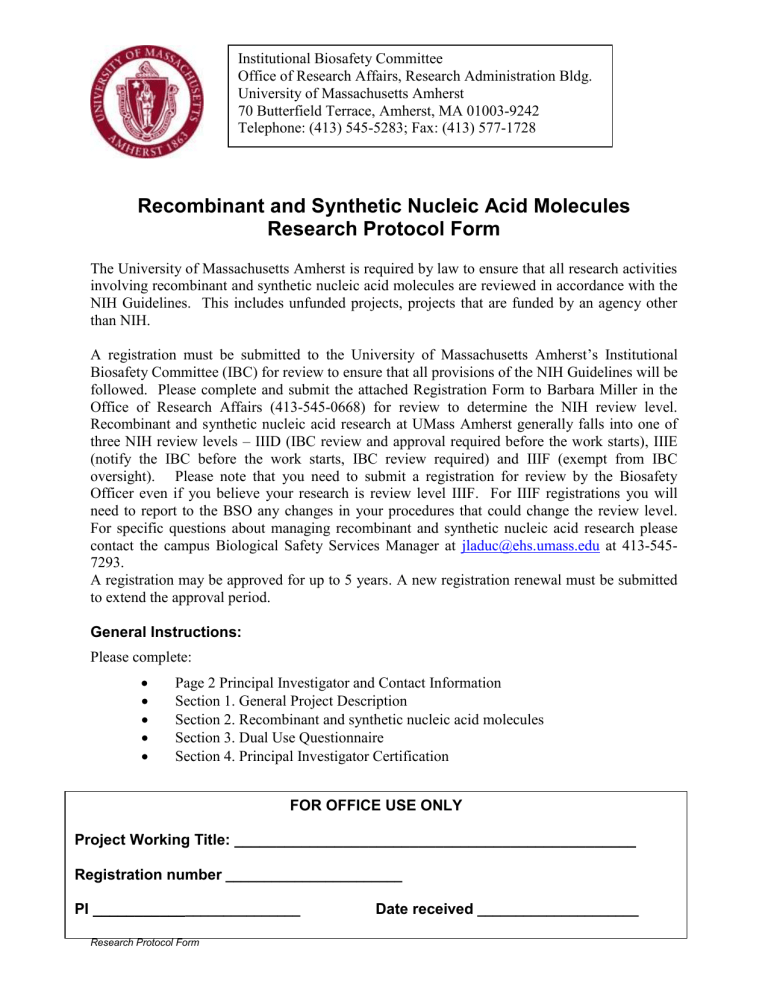
Institutional Biosafety Committee
Office of Research Affairs, Research Administration Bldg.
University of Massachusetts Amherst
70 Butterfield Terrace, Amherst, MA 01003-9242
Telephone: (413) 545-5283; Fax: (413) 577-1728
Recombinant and Synthetic Nucleic Acid Molecules
Research Protocol Form
The University of Massachusetts Amherst is required by law to ensure that all research activities involving recombinant and synthetic nucleic acid molecules are reviewed in accordance with the
NIH Guidelines. This includes unfunded projects, projects that are funded by an agency other than NIH.
A registration must be submitted to the University of Massachusetts Amherst’s Institutional
Biosafety Committee (IBC) for review to ensure that all provisions of the NIH Guidelines will be followed. Please complete and submit the attached Registration Form to Barbara Miller in the
Office of Research Affairs (413-545-0668) for review to determine the NIH review level.
Recombinant and synthetic nucleic acid research at UMass Amherst generally falls into one of three NIH review levels – IIID (IBC review and approval required before the work starts), IIIE
(notify the IBC before the work starts, IBC review required) and IIIF (exempt from IBC oversight). Please note that you need to submit a registration for review by the Biosafety
Officer even if you believe your research is review level IIIF. For IIIF registrations you will need to report to the BSO any changes in your procedures that could change the review level.
For specific questions about managing recombinant and synthetic nucleic acid research please contact the campus Biological Safety Services Manager at jladuc@ehs.umass.edu
at 413-545-
7293.
A registration may be approved for up to 5 years. A new registration renewal must be submitted to extend the approval period.
General Instructions:
Please complete:
Page 2 Principal Investigator and Contact Information
Section 1. General Project Description
Section 2. Recombinant and synthetic nucleic acid molecules
Section 3. Dual Use Questionnaire
Section 4. Principal Investigator Certification
FOR OFFICE USE ONLY
Project Working Title: ________________________________________________
Registration number _______________________
PI ___________ _______________ Date received _____________________
UMass at Amherst Page 1 of 11 form last revised 3/1/2015
Recombinant and Synthetic Nucleic Acid Molecules
Research Protocol Form
Principal Investigator and Contact Information
Responsible PI:
Name:
________________________
Department: ______________________________
Building:
Lab Room Number(s):
______________________________
________________________
Office Phone: ________________ Lab Phone: ________________
E-Mail:_________________________________ Home Phone: ____________________
Campus ID ________________________________
Provide the name and contact information for an alternate contact who can either answer questions for the IBC or an EH&S Inspector and/or who will always be able to contact you.
Alternate Contact:
(A Senior Research Assistant, Lab Manager or Co-PI, who is informed of the lab’s research protocols and safety and emergency response procedures)
Lab Contact ______________________________
Department:
Building:
______________________________
______________________________
Room Number: ______________________________
Office Phone: _____________ Lab Phone __________________
E-Mail: ______________________ Home Phone: __________________
Campus ID ____________________________________
UMass at Amherst
Recombinant and Synthetic Nucleic Acid Molecules
Research Protocol Form
Page 2 of 11 form last revised 3/1/2015
Other Personnel Working on this Project
Name: ________________________ Campus ID_______________
Email: __________________________
Position (e.g. undergrad, grad student, postdoc, technician): _________________________
Name: ________________________ Campus ID_______________
Email: __________________________
Position (e.g. undergrad, grad student, postdoc, technician): _________________________
Name: ________________________ Campus ID_______________
Email: __________________________
Position (e.g. undergrad, grad student, postdoc, technician): _________________________
Name: ________________________ Campus ID_______________
Email: __________________________
Position (e.g. undergrad, grad student, postdoc, technician): _________________________
Name: ________________________ Campus ID_______________
Email: __________________________
Position (e.g. undergrad, grad student, postdoc, technician): _________________________
Name: ________________________ Campus ID_______________
Email: __________________________
Position (e.g. undergrad, grad student, postdoc, technician): _________________________
Name: ________________________ Campus ID_______________
Email: __________________________
Position (e.g. undergrad, grad student, postdoc, technician): _________________________ form last revised 3/1/2015 UMass at Amherst
Recombinant and Synthetic Nucleic Acid Molecules
Research Protocol Form
Page 3 of 11
Section 1. General Project Description
(to be completed for all applications)
Project Title:
______________________________________________________________________________
Project Period: __________ to ____________
Funding Agency: ______________________________________
General Description
Briefly describe the research proposed that involves the use of recombinant or synthetic nucleic acid molecules. Please write your description so that non-scientists on the IBC can understand how you propose to use these materials. Please avoid or define acronyms and abbreviations. Be sure to describe the origin or source of the nucleic acid molecules and the host – vector system you will use. Include a flow chart for complex projects.
UMass at Amherst
Recombinant and Synthetic Nucleic Acid Molecules
Research Protocol Form
Page 4 of 11 form last revised 3/1/2015
Section 2. Recombinant or synthetic nucleic acid molecules
Please identify any of the following that you intend to use in your research:
Does the work involve transfer of a drug resistance trait to an organism that does not acquire it normally (Check "no" for standard drug resistance, e.g., ampicillin into E. coli )?
Does the experiment involve genes coding for molecules toxic to vertebrates
(LD50 <100 nanograms / kg body wt)?
Will the recombinant or synthetic nucleic acids be used in human subjects (human gene transfer experiments)?
Do the experiments involve human genes being cloned into non-pathogenic prokaryotic or lower eukaryotic host-vector systems?
Will there be any large-scale experiments (i.e. requiring more than 10 liters of culture)?
Will genes from one microbe be used to express in another?
Yes No
Are any human or animal pathogens used either as the host organism or as a vector?
Is there the introduction of recombinant or synthetic nucleic acid molecules into
Risk Group 2, 3, 4 or restricted agents as host-vector systems?
Is any DNA from Risk Group 2, 3, or 4 agents or restricted organisms cloned into non-pathogenic prokaryotic or lower eukaryotic host-vector systems?
Do experiments involve recombinant or synthetic nucleic acid molecules and the use of infectious animal or plant viruses in tissue culture systems or in animals?
Do experiments involve the use of defective animal or plant viruses in the presence of helper virus in tissue culture systems or in animals?
Do any recombinant or synthetic nucleic acid molecules contain two-thirds or more of any eukaryotic viral genome?
Do experiments involve whole animals?
Do experiments involve whole plants?
Do experiments involve influenza viruses?
Will you release recombinant or synthetic nucleic acid molecules into the environment?
Will you be breeding transgenic animals to create novel genetically engineered animals?
If you answered NO to all of the questions, your rDNA research may be exempt from the NIH Guidelines i.e. not require full review by the Institutional Biosafety
Committee.
UMass at Amherst
Recombinant and Synthetic Nucleic Acid Molecules
Research Protocol Form
Page 5 of 11 form last revised 3/1/2015
Section 2. (Continued) Recombinant or Synthetic Nucleic Acid
Molecules
To determine whether your project and host-vector system are exempt under NIH Guidelines refer to
the complete text of Section III Experiments Covered by the NIH Guidelines: http://oba.od.nih.gov/oba/rac/guidelines/nih_guidelines.htm#_Toc351276228
1. Where will project be carried out:
Laboratory _____ Yes
Bldg________________ Room______
Greenhouse
Name___________________
Animal Facility
_____Yes
_____Yes
Bldg_____________ Room______
______No
______ No
______No
Environmental Release (Attach USDA application/permit) _____Yes ______ No
Location__________________________
2. Experimental and/or project details involving recombinant or synthetic nucleic acid molecules. If more space is needed for your reply, please create an attachment : a.) Host strain(s) used, (include genus, species, and parent strains): b.) Source of DNA/RNA sequences (include genus, species, gene name and abbr., function of the gene): c.) Recombinant or synthetic plasmid(s)/vectors used (include vector system and sources of
insert): d.) Record selection markers used and their effect (cell lysis, antibiotic resistance, mutations):
UMass at Amherst
Recombinant and Synthetic Nucleic Acid Molecules
Research Protocol Form
Page 6 of 11 form last revised 3/1/2015
e.) Will there be any attempt to obtain expression of the foreign gene? Yes No
If yes, Please describe function and expected action of the gene. f.) If whole plants are used, and the plants will be going to pollination/seed, how will they be contained to avoid releases to the environment? Example: contained in growth chambers, bagging the flowers, etc. g.) Recombinant or synthetic nucleic acid waste must be autoclaved prior to disposal. Please provide the building and room number for the autoclave that you will be using:
Provide the names and contact info for the persons that will be performing this duty (assure that they have received Biosafety Training within the previous 12 months): h.) Please describe surface and liquid decontamination methods and list the product(s) to be used:
3. Provide a brief assessment of the possible risks involved.
What potential hazards would these constructs have? How probable is recombination leading to infectious virus vectors? Is the risk to the investigator, the environment, both?
UMass at Amherst
Recombinant and Synthetic Nucleic Acid Molecules
Research Protocol Form
Page 7 of 11 form last revised 3/1/2015
Check the NIH review category that you consider applies to your project.
Level Approval/Review
III-A NIH Director, RAC,
III-B
IBC
NIH/OBA, IBC
Requirements
A drug resistant gene transferred into a (new) microorganism.
The cloning of toxin molecules with LD
50
< 100 ng/kg of body weight.
III-C
III-D
RAC, IRB, IBC
IBC
†
Recombinant or synthetic nucleic acids (or DNA or RNA derived from recombinant or synthetic nucleic acids) transferred into humans.
Recombinant or synthetic nucleic acid molecules transferred to or from whole animals (including transgenic animals other than rodents); whole plants (noxious weeds or with exotic infectious agents, incorporating vertebrate toxins, or use of microbial pathogens of insects or small animals); experiments involving >10 Liters of culture; using Risk Groups 2, 3, 4 or restricted agents (see below) as host-vector systems; DNA from RG 2, 3, 4 or restricted agents is cloned into non-pathogenic prokaryotic or lower eukaryotic host-vector systems; experiments involving infectious viruses or defective viruses in the presence of helper virus (not a helper cell line); experiments involving influenza viruses.
III-E IBC
§
Recombinant or synthetic nucleic acid molecules involving no more than 2/3 of the genome of any virus of eukaryotes; whole plants (other than those included in III-
D); arthropods; transgenic rodents.
III-F BSO
Ɣ
Recombinant DNA not found in organisms or viruses, single monochromal or viral DNA sources, or host DNA transferred to the same host or related species.
†
Approval required before initiation.
§
Notify IBC when project is initiated. IBC approval still required.
Ɣ
Submission of registration form still required
X
UMass at Amherst
Recombinant and Synthetic Nucleic Acid Molecules
Research Protocol Form
Page 8 of 11 form last revised 3/1/2015
Which Risk Group (RG) applies to the proposed project?
Check the NIH Risk Category that applies to your project.
X
Risk Group 1 Agents that are not associated with disease in healthy adult humans.
(often BSL-1)
Risk Group 2 Agents that are associated with human disease which is rarely serious and for which preventive or therapeutic interventions are often available.
(often BSL-2)
Risk Group 3 Agents that are associated with serious or lethal human disease for which preventive or therapeutic interventions may be available (high individual risk but low community risk). (often BSL-3)
Risk Group 4 Agents that are likely to cause serious or lethal human disease for which preventive or therapeutic interventions are not usually available (high individual risk and high community risk). (often BSL-4)
λ
For a listing of agents, see “Appendix B – Classification of Human Etiologic Agents on the Basis of
Hazard” in the NIH Guidelines For Research Involving Recombinant or Synthetic Nucleic Acid
Molecules, November 2013. http://osp.od.nih.gov/sites/default/files/NIH_Guidelines.html
Section 3. Dual Use Research of Concern
Dual use research of concern is life sciences research that, based on current understanding, can be reasonably anticipated to provide knowledge, information, products, or technologies that could be directly misapplied to pose a significant threat with broad potential consequences to public health and safety, agricultural crops and other plants, animals, the environment, material, or national security.
Does your research involve any experiments that would: Yes No
1 Demonstrate how to render a vaccine ineffective or otherwise enhance the susceptibility of a host population to the agent or toxin
2 Render a pathogen (≥ risk group 2) resistant to antibiotics or antivirals where other effective and readily accessible treatments do not exist
3 Enhance a pathogen's virulence or render a non-pathogen
virulent
4 Increase a replication competent pathogen's transmissibility or ability to disseminate
5
Alter a replication competent pathogen's host range or tropism
6
Enable a pathogen to evade diagnostic tests
7
Enable weaponization of pathogens and toxins
8
Generate or reconstitute an eradicated or extinct agent or toxin
UMass at Amherst
Recombinant and Synthetic Nucleic Acid Molecules
Research Protocol Form
Page 9 of 11 form last revised 3/1/2015
Section 4. Principal Investigator Certification
By submitting this form, I certify that I have read the following statements and agree to abide by them and other UMass policies and procedures governing the use of recombinant DNA, infectious agents and other biological materials, as outlined in this application and in the following:
I will: a) Ensure that listed personnel have received biological safety training http://www.ehs.umass.edu/biological-safety-training i n safe laboratory practices and the procedures for this protocol before any work begins on this project, received follow-up trainings as required by University policy, and that all personnel who could have occupational exposure to bloodborne pathogens have received appropriate bloodborne pathogen training. b) Follow the health surveillance practices outlined by the biosafety officer for this protocol. c) Report accidental exposures or releases to Judy LaDuc, Biological Safety Services Manager
(EH&S) at 413-545-7293. Any releases must be reported to the NIH, therefore I must notify
EH&S so that the appropriate action is taken. d) Have myself or my staff report to UHS (or an Emergency Room) to be seen by medical staff and inform EH&S at 413-545-2682 of any research-related accident or illness as soon as possible after its occurrence. e) Submit a request for approval to the IBC for any significant modifications to the study, facilities or procedures. This request should be submitted to Alison Bardwell abardwel@resgs.umass.edu
and it will be reviewed by the Biological Safety Officer as well as other members of the IBC as deemed necessary. f) Comply with safety practices as described in the most recent version of the Biosafety in
Microbiological and Biomedical Laboratories
2 http://www.cdc.gov/biosafety/publications/bmbl5/index.htm for work with pathogens. g) Ensure that all proposed live vertebrate animal use has been approved by the UMass
Institutional Animal Care and Use (IACUC). h) Ensure that all biohazardous waste and/or sharps waste is decontaminated and handled in accordance with EH&S medical/biological waste guidelines
( http://www.ehs.umass.edu/biological-materials-and-biohazardousmedical-waste-disposalprogram ). Recombinant DNA waste must be autoclaved prior to disposal. Animal carcasses are frozen for at least two days then packaged in bio-boxes for incineration. Sharps containers and bio-boxes are removed for incineration by completing the form on this website: http://www.umass.cems.sr.unh.edu/CEMS/RequestRemoval i) Comply with NIH requirements pertaining to the shipment and transfer of recombinant DNA materials 1 . j) Become familiar with, and abide by, all provisions of the most current NIH Guidelines
1
.
Appendix H – Shipment http://oba.od.nih.gov/rdna/nih_guidelines_oba.html .
k) Recognize that the Biological Safety Officer will review all NIH exempt projects. l) Recognize that I must register any changes in projects including exempt work.
____________________________________________ __________________
Signature (for electronic submission type name)
UMass at Amherst
Recombinant and Synthetic Nucleic Acid Molecules
Research Protocol Form
Page 10 of 11
Date form last revised 3/1/2015
1.
NIH recombinant DNA Guidelines http://oba.od.nih.gov/rdna/nih_guidelines_oba.html
.
2.
CDC / NIH publication Biosafety in Microbiological and Biomedical Laboratories http://www.cdc.gov/biosafety/publications/bmbl5/index.htm
.
3.
OSHA Bloodborne Pathogen Standard: http://www.osha.gov/pls/oshaweb/owadisp.show_document?p_table=STANDARDS&p_id=100
51
4.
Transgenic Animals and the Use of Recombinant DNA in Animals FAQs for Research Subject to the NIH Guidelines: http://oba.od.nih.gov/oba/ibc/FAQs/FAQs%20about%20Transgenic%20Animals%20and%20the
%20Use%20of%20Recombinant%20DNA%20in%20Animals.pdf
5.
Arthropod Containment Guidelines http://online.liebertpub.com/doi/pdf/10.1089/153036603322163475 and http://www.cdc.gov/biosafety/publications/bmbl5/BMBL5_appendixE.pdf
When completed, please return this form to:
Barbara Miller, Program Administrator,
Office of Research Affairs, Research Administration Building,
University of Massachusetts Amherst, 70 Butterfield Terrace
Amherst, MA 01003-9242
Telephone: (413) 545-0668
Fax: (413) 577-1728
Email: bsmiller@research.umass.edu
**** For Institutional Biosafety Committee (IBC) Use Only****
Approve
Approve with
Stipulations
Disapprove
Exempt from IBC
Oversight
NIH Level:
III-A
III-B
III-C
III-D
III-E
III-F
Signature: ________________________________ Date: _____________________
Recombinant DNA/Infectious Agent Registration
UMass at Amherst
Recombinant and Synthetic Nucleic Acid Molecules
Research Protocol Form
Page 11 of 11 form last revised 3/1/2015
